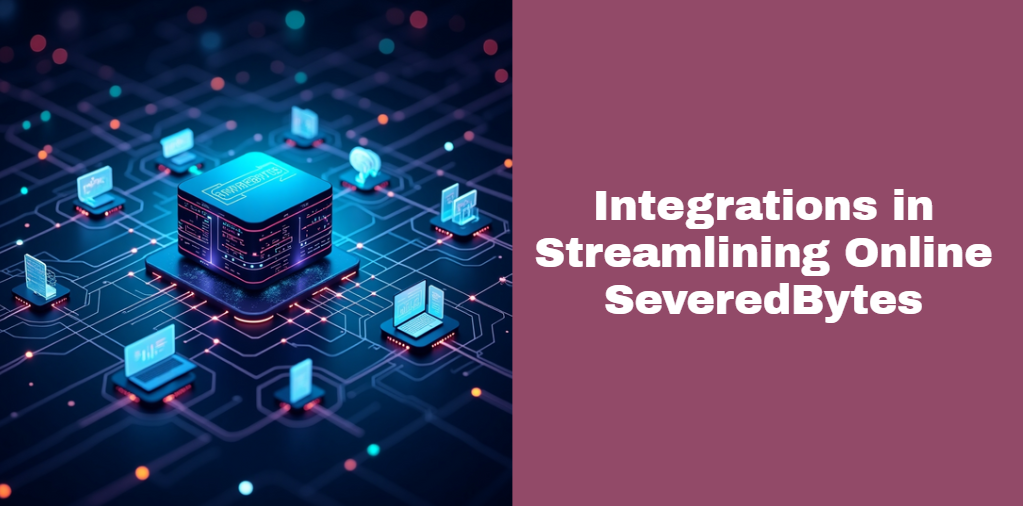Integrations in Streamlining Online SeveredBytes: A Complete Guide to Seamless Digital Transformation
The digital world is evolving faster than ever, and with this evolution comes a growing need for interconnected systems. For platforms like SeveredBytes, which operate in dynamic online environments, having scattered and disconnected systems is a recipe for inefficiency.
Integrations in streamlining online SeveredBytes play a pivotal role in bringing together various applications, data sources, and functionalities into a seamless, unified ecosystem. This transformation not only optimizes workflow but also enhances user experience, automates tasks, and supports future scalability.
Understanding what integrations can do for an online platform like SeveredBytes requires an in-depth exploration of the mechanics behind them, the tools involved, and how they align with business goals. This guide offers just that: a comprehensive, clear, and user-friendly explanation of everything related to integration for SeveredBytes and similar platforms.
Foundations of Integration
To understand how integrations in streamlining online SeveredBytes function, one must first grasp what integration truly means in the tech world. Integration refers to the process of linking together different computing systems and software applications, physically or functionally, to act as a coordinated whole.
There are different types of system integrations:
- Point-to-point integration, where each application is directly connected to another.
- Hub-and-spoke models, where a central hub manages the data flow between applications.
- Enterprise Service Bus (ESB) models, which use a bus-like framework to connect various applications using a common communication method.
SeveredBytes, being a platform that relies heavily on data, automation, and user interface smoothness, benefits greatly from a well-planned integration strategy. This strategy includes lean integration principles that encourage minimal waste, faster deployment, and adaptability.
Key Benefits of Integration
The value of integrations in streamlining online SeveredBytes can be seen in several critical areas:
Operational Efficiency
Through automation of routine processes like order fulfillment, payment processing, and customer support, SeveredBytes can reduce manual workload significantly. This boosts overall productivity, allowing employees to focus on more complex tasks.
Data Accuracy and Consistency
When systems are integrated, they share a single source of truth. This means inventory updates, customer information, and financial data are consistent across all platforms, reducing human error and data duplication.
Scalability and Adaptability
As SeveredBytes grows, it needs to scale its operations smoothly. Integrations allow the platform to add new tools and services without disrupting existing workflows. This flexibility is crucial for evolving digital businesses.
Security and Compliance
Modern integration tools support encryption, authentication, and compliance monitoring. This ensures that user data is handled securely and meets regulatory requirements like GDPR or HIPAA.
Enhanced User Experience
By integrating customer-facing services like chatbots, personalized product recommendations, and real-time notifications, SeveredBytes enhances the overall user experience and satisfaction.
Integration Use Cases for SeveredBytes
Different integration scenarios apply to SeveredBytes depending on its business model and services. Some common use cases include:
| Use Case | Integration Type | Benefit |
|---|---|---|
| E-commerce | CMS, Payment Gateway, Logistics | Streamlined checkout, order tracking |
| CRM | Salesforce, HubSpot | Centralized customer data and engagement tracking |
| ERP Systems | NetSuite, SAP | Unified backend operations |
| APIs/Webhooks | RESTful APIs | Real-time communication between services |
| BI & Analytics | Tableau, Google Analytics | Actionable business insights from data |
Each of these use cases serves to align operational goals with technical capabilities, ensuring that the entire SeveredBytes ecosystem operates like a well-oiled machine.
Technology Stack and Tools
To successfully implement integrations in streamlining online SeveredBytes, it is essential to understand the available tools and technologies. The following are among the most widely used:
- Cloud-based Integration Platforms (iPaaS): Tools like Zapier, Celigo, and Boomi allow cloud-based automation and integration without deep coding knowledge.
- Middleware: These are software layers that act as a bridge between disparate systems, ensuring smooth communication and data flow.
- API Management Tools: APIs are the backbone of modern integration. Tools like Postman, Apigee, and Swagger help develop, monitor, and secure these APIs.
- ETL Tools (Extract, Transform, Load): Used for data migration and transformation, enabling clean data flow between platforms.
- RPA (Robotic Process Automation): These tools automate repetitive tasks and workflows without needing human intervention.
This stack forms the backbone of SeveredBytes’ integration architecture, ensuring every component communicates efficiently.
Integration Architecture Models
Choosing the right architecture is crucial. SeveredBytes can utilize various models:
- Point-to-Point: Ideal for small setups but becomes unmanageable at scale.
- Hub-and-Spoke: A central hub reduces redundancy and is easier to manage.
- Enterprise Service Bus (ESB): Best for large-scale systems requiring high interoperability.
Each model comes with trade-offs in terms of complexity, scalability, and cost, so it’s essential to match the architecture with SeveredBytes’ goals.
Implementation Challenges
Even though integrations in streamlining online SeveredBytes offer multiple advantages, implementation can be challenging:
- Complexity Management: As more systems are integrated, managing them becomes harder. Proper documentation and modular designs are vital.
- Resource Constraints: Integration projects need skilled developers, IT support, and time. Without proper planning, they may drain resources.
- Security Concerns: Integrated systems increase attack surfaces. Ensuring encrypted data transfer and multi-factor authentication is critical.
- Legacy System Compatibility: Older systems may not support modern APIs or integration tools. This requires using adapters or performing system upgrades.
Best Practices and Methodologies
To overcome challenges and ensure smooth integration, consider the following methodologies:
- Start Small: Begin with high-impact, low-risk integrations before expanding.
- Follow Lean Principles: Avoid unnecessary features and focus on delivering value fast.
- Document Everything: Every integration should be documented for future maintenance and scalability.
- Test and Monitor: Use sandbox environments and real-time monitoring tools to detect and resolve issues early.
- Engage Stakeholders: Regular input from business users ensures that integrations meet real-world needs.
By adopting these best practices, SeveredBytes can ensure the longevity and success of its integration efforts.
Case Study: Hypothetical Workflow at SeveredBytes
Imagine a scenario where SeveredBytes runs an online store integrated with a CRM, ERP, and analytics dashboard.
- A customer places an order via the website (integrated with CMS and payment gateway).
- The order details are instantly sent to the ERP system (inventory update, order processing).
- CRM records the purchase and triggers a personalized thank-you email.
- The analytics dashboard updates real-time KPIs for management.
Result: This seamless integration reduces fulfillment time, improves customer engagement, and enhances decision-making—all without manual intervention.
Future Trends and Innovations
Looking ahead, the role of integrations in streamlining online SeveredBytes will grow with the advent of new technologies:
- AI-Powered Integrations: Predictive analytics and smart data routing will reduce manual workflows even further.
- Event-Driven Architectures: These allow systems to react in real time to specific triggers, improving responsiveness.
- Blockchain-Based Integrations: Useful for secure, decentralized data validation and transaction recording.
These emerging trends will shape the future of SeveredBytes, keeping it competitive and innovative in a crowded digital landscape.
Conclusion and Next Steps
Integrations are no longer optional—they are the foundation of any efficient, scalable, and customer-centric online platform. For SeveredBytes, integrating various systems isn’t just about convenience; it’s about survival in a data-driven market.
By understanding the technical foundations, leveraging modern tools, and applying best practices, SeveredBytes can harness the power of integrations to automate operations, improve user experiences, and scale for future growth.
Suggested Roadmap:
| Step | Action |
|---|---|
| 1 | Identify critical systems needing integration |
| 2 | Choose the appropriate architecture and tools |
| 3 | Execute a pilot integration project |
| 4 | Scale and monitor with performance metrics |
| 5 | Continuously iterate and improve |
Recommended Articles
Trey Kulley Majors: Biography, Career, Family and Life Behind the Scenes
MSI Quartz vs Vadara: A Complete Comparison for Homeowners & Designers
Mariquita S.R.L.S Lodi: A Growing Force in Italy’s Restaurant Industry
19721 Liberty One Dollar Coin Value – Full Guide to History, Varieties & Worth





